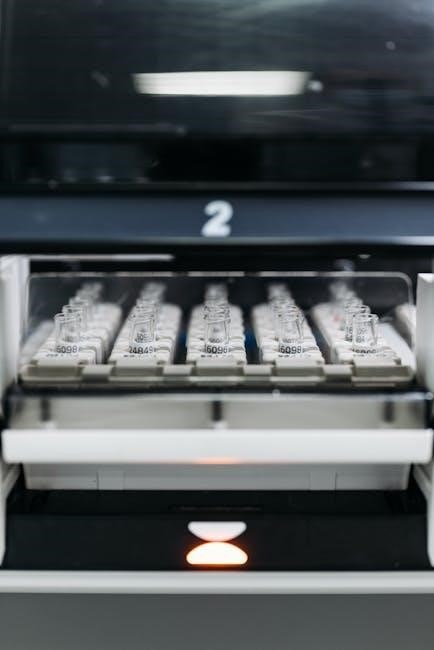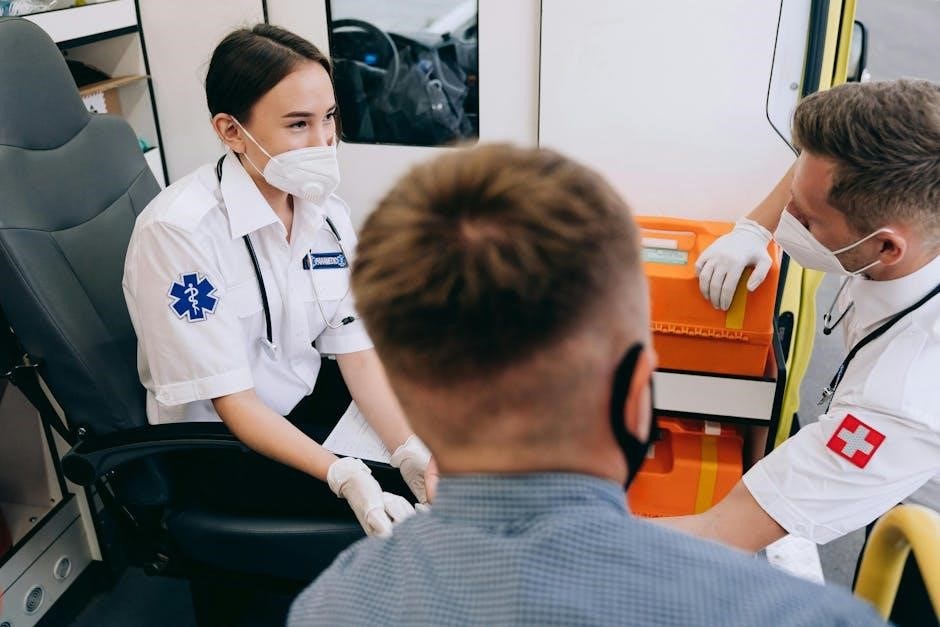Importance of a Well-Structured Medical Assistant Resume
A well-structured medical assistant resume is essential for showcasing skills, experience, and certifications in a professional and organized manner, helping employers quickly assess your qualifications․
1․1․ Why a Medical Assistant Resume is Crucial for Landing a Job
A well-crafted medical assistant resume is vital for standing out in a competitive job market․ It serves as your first impression, showcasing your skills, certifications, and experience to potential employers․ A structured resume highlights your ability to perform both clinical and administrative tasks, demonstrating your value as a versatile healthcare professional․ Employers rely on resumes to quickly assess candidates, making it essential to present your qualifications clearly and professionally․
1․2․ Key Features of an Effective Medical Assistant Resume
An effective medical assistant resume should include a clear skills section, detailed work experience, education, and certifications․ Highlight clinical and administrative abilities, such as patient care, lab procedures, and HIPAA compliance․ Use strong action verbs and quantify achievements when possible․ Ensure a clean, professional design with bullet points for readability․ Tailor the resume to the job description, emphasizing relevant experience and skills that align with the employer’s needs․

Objective Statement and Professional Summary
A strong objective statement and professional summary capture employers’ attention, conveying your career goals and highlighting your skills, experience, and certifications as a medical assistant․
2․1․ Crafting a Compelling Objective Statement
A strong objective statement is concise, tailored to the job, and highlights your skills, experience, and career goals․ It should clearly convey your passion for the medical field and how you aim to contribute to patient care․ Incorporate specific skills like clinical procedures, patient interaction, and administrative tasks to grab the employer’s attention․ Keep it professional and aligned with the job description to stand out․
2․2․ Writing a Strong Professional Summary
A professional summary should be concise, highlighting relevant experience, skills, and certifications․ Tailor it to the job description, emphasizing your ability to provide quality patient care and support clinical operations․ Mention certifications like CMA or RMA and include specific skills such as electronic health records or phlebotomy․ This section should quickly convey your value as a medical assistant and align with the employer’s needs․
Highlighting Relevant Skills
Highlighting essential medical assistant skills, such as patient care, phlebotomy, and EHR proficiency, demonstrates your readiness for clinical and administrative tasks, making you a standout candidate․
3․1․ Essential Skills for a Medical Assistant Resume
Include skills like patient care, HIPAA compliance, EHR proficiency, phlebotomy, and administering injections․ Highlight clinical and administrative abilities, such as scheduling appointments and managing records․
- Patient assessment and vital sign measurement
- Infectious disease mitigation and safety protocols
- Medical terminology and coding knowledge
These skills demonstrate your versatility and readiness for healthcare roles․
3․2․ Spotlight on Skills: Presenting Them Effectively
Present your skills clearly by categorizing them into clinical and administrative abilities․ Use bullet points for easy readability and include specific examples from your experience․ Highlight certifications like HIPAA compliance and EHR proficiency to showcase your expertise․ This structured approach ensures employers quickly identify your qualifications and capabilities, making your resume stand out in a competitive job market․
- Use action verbs to describe skill applications
- Quantify achievements where possible
Work Experience and Clinical Practicum
Detailing your work experience and clinical practicum is crucial for demonstrating hands-on skills and real-world application of medical assisting knowledge․ Include specific tasks, such as administering injections or scheduling appointments, and highlight achievements like improving patient flow or ensuring compliance with regulations․ This section allows employers to assess your practical capabilities and readiness for the role․
- Describe roles and responsibilities clearly
- Quantify achievements when possible
4․1․ Documenting Work Experience in Healthcare
When documenting work experience in healthcare, focus on clarity and relevance․ Include specific tasks like patient intake, administering injections, and scheduling appointments․ Highlight achievements, such as improving efficiency or ensuring HIPAA compliance․ Use action verbs like “performed” or “managed” to describe responsibilities․ Quantify accomplishments when possible to demonstrate impact․ Keep the language professional and concise, ensuring each bullet point aligns with the job description․
- Be specific about job roles and duties
- Highlight relevant skills and achievements
- Use professional language
4․2․ Including Clinical Practicum and Internships
Including clinical practicum and internships in your resume highlights hands-on experience and practical skills․ Describe specific tasks, such as patient assessments or vital sign monitoring, to showcase your ability to apply knowledge in real-world settings․ Mention the duration and location of each experience․ This demonstrates adaptability and commitment to employers, proving you are prepared for the demands of a medical assistant role․
- Detail responsibilities and achievements
- Highlight skills gained during training
- Quantify accomplishments when possible
Education, Certifications, and Training
Highlighting your educational background, certifications, and professional development showcases your qualifications and expertise․ Include degrees, training programs, and certifications like CMA or RMA to demonstrate your readiness for the role․
5․1․ Listing Educational Background and Degrees
Clearly list your educational background, starting with the most recent degree․ Include the degree earned, institution name, and graduation date․ Mention any honors or relevant coursework․ Highlight certifications like CMA or RMA, as they demonstrate professional competence․ Ensure the information is concise and professionally presented, making it easy for employers to verify your qualifications and assess your readiness for the role․
5․2․ Highlighting Certifications and Professional Development
Highlight certifications like Certified Medical Assistant (CMA) or Registered Medical Assistant (RMA) to demonstrate professional competence․ Include any specialized training or workshops, such as infectious disease mitigation or HIPAA compliance․ Mention continuing education courses or professional memberships to show commitment to staying updated in the field․ This section showcases your dedication to maintaining high standards and adapting to industry advancements, making you a more attractive candidate․

Cover Letter and Additional Documents
A well-crafted cover letter introduces your professional background and aligns your qualifications with the job requirements․ Include additional documents like certifications or references to strengthen your application․
6․1․ Writing a Professional Cover Letter
A professional cover letter should be concise, tailored to the job, and highlight your relevant experience and skills․ Begin with a strong opening, introduce your background, and connect your qualifications to the employer’s needs․ Use specific examples to demonstrate your expertise in patient care, administrative tasks, and compliance with regulations like HIPAA․ Conclude by expressing enthusiasm for the role and thanking the reader for their time․ Keep it to three to four paragraphs, ensuring clarity and professionalism․
6․2․ Including Additional Supporting Documents
Include certifications, transcripts, and letters of recommendation to strengthen your application․ These documents provide evidence of your qualifications and skills․ Certifications like CMA or RMA demonstrate professional competence, while clinical practicum details showcase hands-on experience․ Ensure all documents are updated and relevant to the job․ Organize them neatly and submit them alongside your resume and cover letter for a comprehensive application package․
Resume Formatting and Design
A clean, professional layout and simple design are essential for a medical assistant resume․ Save as PDF to ensure a neat appearance on any device․
7․1․ Choosing the Right Format for Your Resume
Choosing the right format for your medical assistant resume is crucial for professionalism and readability․ Opt for a clean, simple layout that highlights your skills and experience․ PDF format is highly recommended as it preserves your design and ensures consistency across devices․ Avoid overly decorative templates, as they can distract from your qualifications․ Select a format that aligns with your experience level, such as chronological or functional, to present your credentials effectively․
7․2․ Professional Design: Clean and Organized Layout
A clean and organized layout is vital for a professional medical assistant resume․ Use a simple, uncluttered design with consistent fonts, spacing, and headings․ Avoid overly decorative elements, as they can distract from your qualifications․ Ensure proper alignment and bullet points for readability․ A well-designed resume ensures your skills and experience stand out, making it visually appealing and easy for employers to review․

Tailoring Your Resume to the Job
Tailoring your resume to each job application is crucial for highlighting relevant skills and experiences that match the employer’s needs, ensuring your application stands out․
8․1․ Customizing Your Resume for Each Application
Customizing your resume for each application ensures it aligns with the job requirements, emphasizing relevant skills and experiences․ This involves tailoring your objective, skills section, and work experience to match the job description․ Including specific keywords from the job posting improves readability for applicant tracking systems (ATS)․ A personalized approach highlights your suitability for the role, making your resume stand out to employers seeking the best fit for their team․
8․2․ Using Keywords from the Job Description
Using keywords from the job description enhances your resume’s relevance and improves its visibility to applicant tracking systems (ATS)․ Incorporate terms like “HIPAA compliance,” “patient intake,” or “vital sign measurement” to align with the employer’s requirements․ This practice ensures your resume passes through ATS filters and demonstrates your suitability for the role, increasing the likelihood of catching the hiring manager’s attention․

Action Verbs and Descriptive Language
Action verbs like “administered,” “conducted,” and “recorded” make your resume dynamic, while descriptive language quantifies achievements, showing the impact of your work in healthcare settings clearly․
9․1; Using Strong Action Verbs in Your Resume
Strong action verbs like “administered,” “conducted,” and “recorded” enhance your resume by showcasing your active role in healthcare settings․ These verbs highlight your responsibilities and achievements, making your experience more tangible․ For example, “Administered vaccinations to 50+ patients monthly” demonstrates both task and impact, aligning with job descriptions and impressing employers․ Using such verbs ensures clarity and professionalism, making your resume stand out․
9․2․ Describing Achievements and Responsibilities
Clearly detailing your achievements and responsibilities strengthens your resume by providing concrete evidence of your capabilities․ For example, mention specific tasks like “Conducted 30+ patient intake interviews daily” or “Managed inventory, reducing supply costs by 15%․” Quantify accomplishments to demonstrate impact, such as “Administered 100+ vaccinations monthly” or “Improved patient wait times by 20% through efficient scheduling․” This approach showcases your value to potential employers․
Saving and Submitting Your Resume
Saving your resume as a PDF ensures professional formatting and readability across devices․ Submitting it through proper channels, like employer websites or email, maximizes visibility and impact․
10․1․ Why Saving Your Resume as a PDF is Essential
Saving your resume as a PDF preserves the layout, formatting, and design elements, ensuring it looks professional on any device․ This format maintains consistency, preventing text or images from shifting․ Employers often prefer PDFs for their universal compatibility and professional appearance․ It also safeguards against formatting errors, making it the ideal choice for submitting applications․ A well-formatted PDF resume enhances your credibility and ensures your qualifications are presented clearly․
10․2․ Submitting Your Resume for Maximum Impact
Submitting your resume as a PDF ensures compatibility and maintains a professional appearance across devices․ Tailor your resume to match the job description, incorporating relevant keywords to pass Applicant Tracking Systems (ATS)․ Pair it with a cover letter to provide context and showcase your enthusiasm․ Ensure the design is clean and organized, as a visually appealing resume increases the likelihood of catching the hiring manager’s attention and securing an interview․